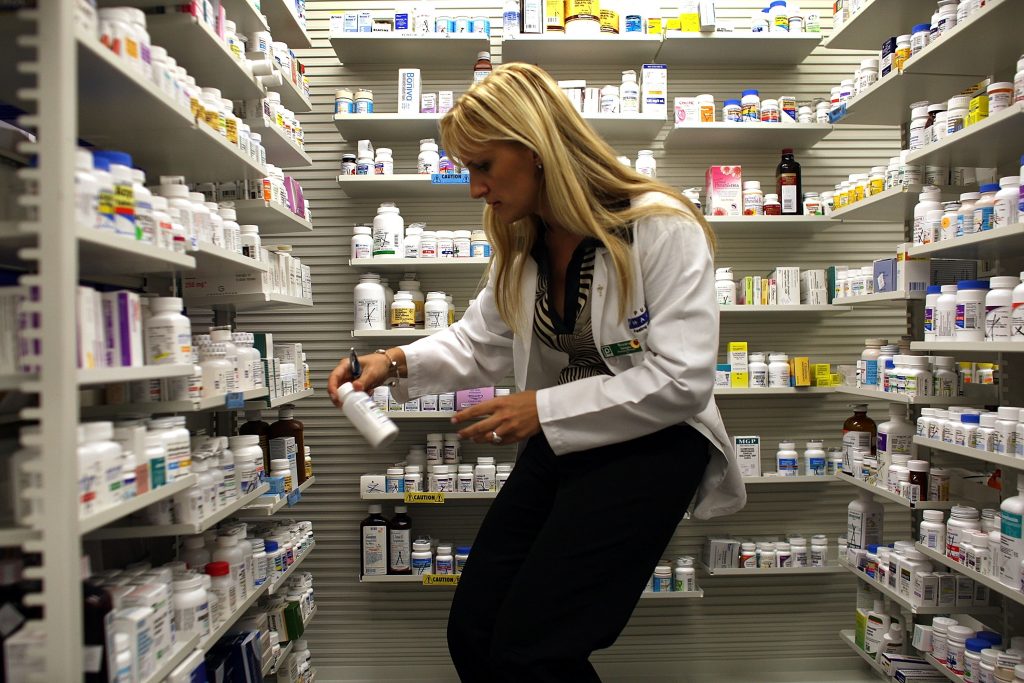A Publix Super Markets pharmacy manager retrieves a medication in Miami. Photo by Joe Raedle/Getty Images.
At a time when Maryland could be accelerating medical innovation to meet the world’s health challenges, our state’s policymakers are taking steps that could curb medical advancements and disrupt patient access and care.
The state’s Prescription Drug Affordability Board (PDAB), established in 2019, voted recently to start the process of imposing Upper Payment Limits (UPLs) on up to six medications that treat heart disease, diabetes, Crohn’s disease and more. A UPL does not lower a patient’s out-of-pocket costs like copays, deductibles or coinsurance, but instead would cap the amount of reimbursement for a drug that providers, pharmacies and other health care facilities would receive.
The PDAB’s vote came after patient advocates and medical innovators expressed grave doubts about the board’s rationale and the lack of transparency into their process.
As a member of the PDAB’s stakeholder advisory council, I have serious concerns that establishing UPLs in Maryland will have two unintended consequences. It will harm Maryland’s life sciences ecosystem, which is one of our biggest economic engines, and it will do nothing to directly improve patient affordability or access to care.
First, the PDAB’s decisions could cause a chilling effect on medical innovation in our state. Maryland’s life sciences ecosystem – comprising 2,700 companies, 54,000 workers and top federal and academic research institutions – develops cures, therapies, and treatments that millions of patients depend on.
Arbitrary price controls jeopardize their ability to invest in research and clinical trials to discover breakthroughs in treatment for cancer and other diseases. Maryland should be incentivizing investment, not potentially limiting it.
Second, the PDAB’s flawed process for setting UPLs neglects the actual costs patients pay for drugs. By considering only a drug’s net cost, the PDAB fails to account for how insurance plans and Pharmacy Benefit Managers (PBMs) impact patient costs. Insurance carriers and PBMs often receive sizable rebates from drug manufacturers, but aren’t required to share those savings with patients. The PDAB can’t discern a drug’s cost without considering PBMs and insurance carrier costs.
Moreover, setting arbitrary UPLs could restrict patient access to medications as supply chains are disrupted and health plans adjusted, resulting in health disparities and loss of access to treatments that had been prescribed by a provider, not by a five-person quasi-public panel.
Many stakeholders across the health care ecosystem have expressed concerns of the unintended consequences of setting a UPL. Health HIV, an organization advocating for people with HIV, warned, “any disruptions in access to necessary medications due to UPLs could lead to an increase in HIV infections and overall healthcare costs.”
These comments and others like them should prompt the PDAB to immediately pause its work and fix these flaws. If they do, they won’t be alone.
Oregon’s Prescription Drug Affordability Board recently delayed its cost review for similar reasons. Their survey of stakeholders found that, “more than half of respondents did not believe a UPL would result in cost savings, with many expressing concerns regarding loss of revenue, decreased patient access, and increased patient costs.”
We can improve patient affordability without harming our life sciences workforce, or patient access, by considering all factors contributing to out-of-pocket costs. For example, Maryland’s Share the Savings Act would require carriers and PBMs to share up to 85% of drug rebate savings with patients. The General Assembly should take this bill up in January and bear in mind a simple question: Why not let patients benefit?
The Board’s process has left patients and providers to question the Board’s commitment. Ninety seconds to testify or submit comments without dialogue shows a lack of interest in patient concerns.
The PDAB must allow for more feedback from patients, providers and other stakeholders. They’ll learn that UPLs, by potentially restricting access to medications, may force patients onto alternative medications that don’t meet their needs, potentially leading to harm and increasing costs elsewhere in the health care continuum. Nonmedical switching, a practice banned in several states, will now be codified by a UPL.
The PDAB’s misguided focus on drug price controls risks medical innovation and jobs in Maryland while doing nothing to improve drug affordability or protect Marylanders’ access to medicines.

